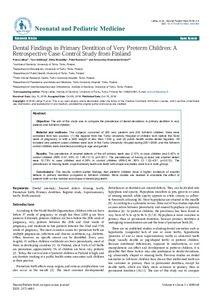Dental Findings in Primary Dentition of Very Preterm Children: A Retrospective Case-Control Study from Finland
Anna-Liisa Svedström-Oristo; Elina Maaniitty; Petra Lüthje; Tero Vahlberg; Päivi Rautava
https://urn.fi/URN:NBN:fi-fe2021042719983
Tiivistelmä
Objective: The aim of this study was to compare the prevalence of dental deviations in primary dentition in very preterm and full-term children.
Material and methods: The subjects consisted of 205 very preterm and 205 full-term children. Data were combined from two sources: (1) the register from the Turku University Hospital of children born before the 32nd week of pregnancy or with a birth weight of less than 1,500 g, and (2) public health centre dental registers. All included very preterm (case) children were born in the Turku University Hospital during 2001-2006, and the full-term control children were matched according to age and gender.
Results: The prevalence of enamel defects of the all primary teeth was 2.10% in case children and 0.42% in control children (RR= 5.07, 95% CI 1.96-13.13, p=0.001). The prevalences of having at least one enamel defect were 10.73% in case children and 4.39% in control children (RR=2.44, 95% CI 1.22-4.91, p=0.012). The prevalences of missing teeth, supernumerary teeth and teeth with shape anomalies were low in both groups.
Conclusions: The results confirm earlier findings that preterm children have a higher incidence of enamel defects in primary dentition compared to full-term children. More studies are needed to elucidate the effect of preterm birth on the number and shape of developing teeth.
Kokoelmat
- Rinnakkaistallenteet [19207]
